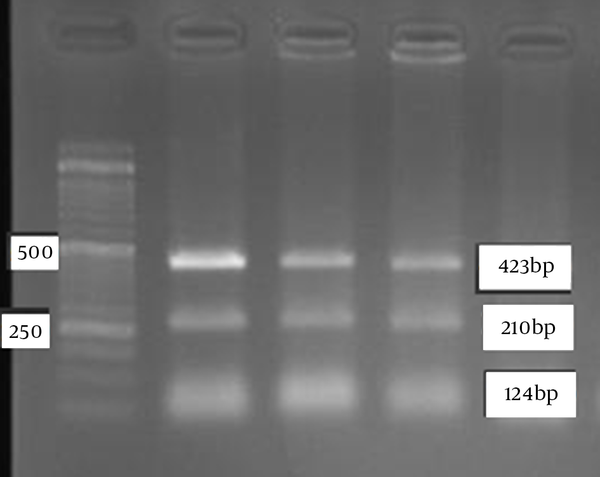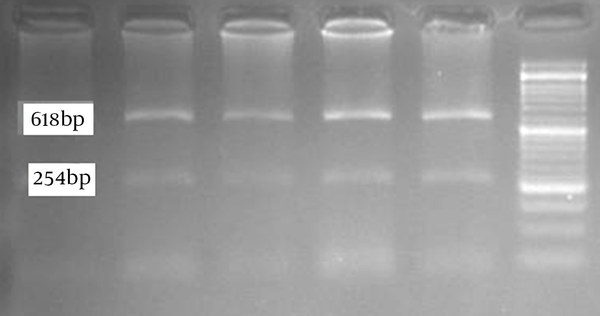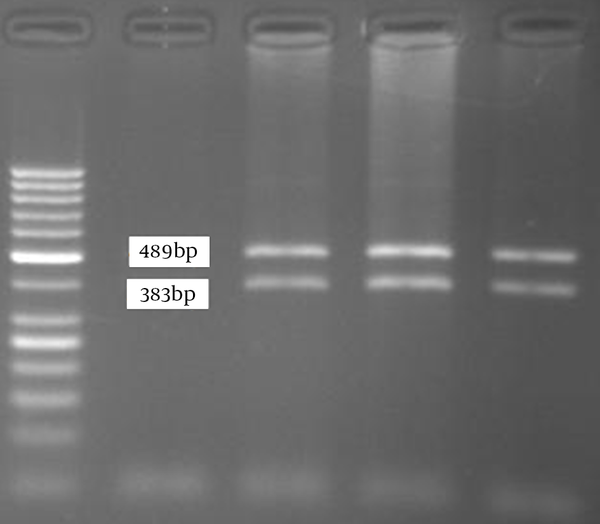Abstract
Background:
Glaucoma is the second leading cause of blindness worldwide, and it is associated with increased intraocular pressure and visual field loss. The most common type of glaucoma, primary open-angle glaucoma (POAG), involves progressive optic nerve damage and the death of ganglion cells in adults. Despite the unknown etiology, genetic predisposition plays a significant role in the development of the disease.Objectives:
In order to identify the genetic basis of POAG in Zahedan, Iran, three common mutations of the CYP1B1 gene (G61E, R390H, and R469W) were evaluated in this study.Patients and Methods:
Forty patients with POAG were recruited from the ophthalmic divisions of Alzahra hospital, which is associated with Zahedan University of Medical Sciences. The CYP1B1 prevalent mutations of p.G61E, p.R390H, and p.R469W were identified in DNA extracted from the blood samples of patients using the polymerase chain reaction-restriction fragment length polymorphism (PCR-RFLP) technique.Results:
We identified no mutations in these patients in the three screened positions.Conclusions:
To ensure that these genes play no role in the disease, evaluation of the non-coding regions of both the CYP1B1 and MYOC genes is strongly recommended, since other genes are involved in the pathogenesis of glaucoma.Keywords
POAG (Primary Open-Angle Glaucoma) Genetics Polymerase Chain Reaction-Restriction Fragment Length Polymorphism (PCR-RFLP) Iran CYP1B1 Gene Mutation
1. Background
Glaucoma is a group of progressive neuropathies of the optic nerve, which are characterized by a decline in the retinal ganglion cells and then optic nerve damage, thereby contributing to a specific pattern of irreversible blindness if left undetected or not treated in time. The disease is the second leading cause of blindness worldwide after cataract (1).
Glaucoma has been classified into many categories based on etiology (primary or secondary), anatomy of the anterior chamber (open-angle or angle-closure glaucoma), and age of onset (congenital, juvenile, or adults glaucoma) (2). Primary open-angle glaucoma (POAG; OMIM #137760) is the most common form of glaucoma in adults. POAG is associated with increased intraocular pressure (IOP) in those of advanced ages. In most cases, a family history of the disease can also be attributed (3).
Many loci have been identified for glaucoma, although the main molecular mechanism of the disease remains unknown (4). However, a few genes have been identified as contributing to POAG, including the MYOC gene (OMIM #601652) on chromosome 1q24.3, the WDR36 gene (OMIM #609669) on chromosome 5q22.1, and the OPTN gene (OMIM #602432) on chromosome 10p13 (1, 5). Further studies have revealed the co-inheritance of multiple genes in glaucoma. In France (6, 7), India (2), Iran (8), Spain (5), and many other areas the simultaneous role of the CYP1B1 and MYOC genes in the occurrence of the disease has been observed.
The CYP1B1 gene (OMIM #601771) is a major cause of primary congenital glaucoma (PCG; OMIM #231300) and it encodes a 543-amino acid CYP1B1 protein as a member of the cytochrome P450 family (6, 7). It is located on chromosome 2p22.2 and consists of two coding exons. The CYP1B1 gene is the gene usually linked with primary congenital glaucoma, although mutations in the CYP1B1 gene have been reported in individuals affected by primary and juvenile open-angle glaucoma as well (7).
2. Objectives
In the current study, the presence of the most common CYP1B1 gene mutations (p.G61E, p.R390H, and p.R469W) (2) was investigated in 40 POAG patients from Zahedan in Sistan and Baluchestan Province in the southeast of Iran.
3. Patients and Methods
3.1. Study Population
In this study, 40 unrelated POAG patients were recruited from the ophthalmic divisions of Alzahra hospital, which is associated with Zahedan University of Medical Sciences. All of the patients were diagnosed by glaucoma specialists. The examination involved gonioscopy of the angle, slit lamp biomicroscopy, evaluation of the IOP, and fundus perimetry.
Elevated IOP (more than 21 mmHg) and optic disc cupping in at least one eye were considered as specific symptoms of POAG. Patients with other ocular or systemic anomalies were excluded. All participants provided written informed consent according to the declaration of Helsinki and the accepted codes of the university ethics committee.
3.2. Genomic DNA Extraction and Genotyping
Genomic DNA was extracted via the salting out method from the whole blood of the patients (8). The CYP1B1 prevalent mutations of p.G61E, p.R390H, and p.R469W were identified using the polymerase chain reaction-restriction fragment length polymorphism (PCR-RFLP) technique. The primers corresponded to the sequences adjacent to exon 2, which contains the initiation codon:
(2F: 5’-GCATGATGCGCAACTTCTTCACG-3’; 2R: 5’-TCACTGTGAGTCCCTTTACCGAC-3’). The coding region of exon 3 was amplified with primers: (3F: 5’-AATTTAGTCACTGAGCTAGATAGCC-3’; 3R: 5’- TATGGAGCACACCTCACCTGATG-3’). The amplicons of exon 2 and exon 3 included 757 and 872 nucleotides, respectively. The restriction enzymes used for p.G61E, p.R390H, and p.R469W were TaqI, HahI, and AciI (Fermentas, Vilnius, Lithuania), respectively. The PCR-RFLP products were evaluated using electrophoresis on a 2% agarose gel and then visualized with ethidium bromide staining.
4. Results
In the current study, 40 POAG patients with a mean age of 47 ± 14 years and a mean age of onset of 46 ± 12 years were genotyped for the prevalent mutations of G61E, R390H, and R469W in the CYP1B1 gene. Some 52.6% of participants were male and 47.4% were female.
The mean cup/disk ratio for both the right eye (OD) and the left eye (OS) was 0.7 ± 0.2. Approximately 74% of the patients had no history of trabeculectomy, while 19.4% had a history of surgery in both eyes and the others had had just one eye surgery. As all of the patients received medications at the time of this study, all of them had a controlled IOP of 18 ± 6.7 mmHg for the OD and 16.8 ± 3.7 for the OS.
Although a prior study had demonstrated that the three abovementioned mutations in the CYP1B1 gene cause more than 50% of glaucoma in central and western Iran (2), we identified no mutations in the participating patients in the three screened positions. The results of two patients were confirmed using direct sequencing of the coding exons.
The TaqI restriction enzyme digests the PCR product of a fragment of exon 2 with a length of 757 bp, and it creates three pieces of 423 bp, 210 bp and 124 bp in a normal sequence. All of the patients showed this pattern of digestion, so all of them were considered as normal (Figure 1).
The Results of TaqI Digestion for the Detection of p.G61E

The HahI restriction enzyme digests the PCR product of a fragment of exon 3 and creates two pieces of 618 bp and 254 bp in a normal sequence. All of the patients and their parents showed this pattern of digestion. The p.R390H mutation occurs at nucleotide number 1169 (A to G), and then there is no restriction enzyme cleavage for HahI (Figure 2).
The Results of HahI Digestion for the Detection of p.R390H

After the digestion of the PCR product of exon 3 of the CYP1B1 gene by the AciI restriction enzyme, normal sequences appeared with two pieces of 489 bp and 383 bp. The digestion results of each of the 40 patients were similar, with no mutation found in this position (Figure 3).
The Results of AciI Digestion for the Detection of p.R469W

None of the patients examined in this study showed any of the abovementioned mutations (i.e. p.G61E, p.R390H, and p.R469W of the CYP1B1 gene). The results of the RFLPs were confirmed by direct sequencing of the amplicons using an ABI Prism 3700 instrument (applied Biosystems, Foster city, CA).
5. Discussion
Glaucoma is a group of progressive neuropathy of the eye that are associated with optic nerve damage. The disease causes a reduction in retinal ganglion cells and then leads to visual field loss, which makes glaucoma the second leading cause of blindness worldwide after cataract.
It has been shown that a family history of glaucoma is a risk factor for developing POAG. Hence, an individual’s genetic background is considered to be one of the most important criteria in the patient evaluation.
Although the CYP1B1 gene was first identified in relation to primary congenital glaucoma (6) and the MYOC gene to primary open-angle glaucoma (9, 10), further studies proposed the complex relationship of these genes in the development of glaucoma.
In a study conducted in 2002, the CYP1B1 gene was found to be the cause of 5% of all juvenile open-angle glaucoma (11). This study was the basis for further research in this area among other populations.
Then, the role of the CYP1B1 gene mutation in POAG patients in different populations was studied. Mutation in the CYP1B1 gene correlated with POAG in one population in India (12, 13), although it proved rare in other studies in India (14), Iran (15), Spain (7), Pakistan (16), and China (17), albeit not in all studies (18).
On the other hand, some studies revealed correlations of mutations in the MYOC gene with primary congenital glaucoma in some populations (19, 20); hence, the other studies rejected this finding (21, 22).
In a study involving patients affected by primary congenital glaucoma that was conducted in Iran in 2007, the p.G61E, p.R390H, p.R469W mutations were introduced as the most common disease-causing mutations (2). In 2008, patients with primary open-angle glaucoma were evaluated for mutations in the CYP1B1 and MYOC genes. Mutations in both genes were found to be equally involved in the disease. The p.G61E and p.R390H mutations in the CYP1B1 gene were the cause of 17.4% of instances of the disease, on a homozygous state (15).
Since no prior research had been conducted in the southeast of Iran with regard to the genetics of glaucoma, we did not know which gene or genes are involved in the disease. Thus, the purpose of this study was to take the first step in identifying the genetic basis of glaucoma in this area. Some forty unrelated patients with primary open-angle glaucoma who were referred to the ophthalmic divisions of Alzahra hospital participated in this study. As none of them showed any mutation in the coding exons of the MYOC gene (data not published), all of the patients were subject to the evaluation of three common mutations in the CYP1B1 gene (p.G61E, p.R390H, and p.R469W) using the PCR-RFLP technique, but none of the patients showed these mutations. To ensure that these genes play no role in the disease, evaluation of the non-coding regions of both the CYP1B1 and MYOC genes is strongly recommended, since other genes are involved in the pathogenesis of glaucoma.
References
-
1.
Chakrabarti S, Kaur K, Komatireddy S, Acharya M, Devi KR, Mukhopadhyay A, et al. Gln48His is the prevalent myocilin mutation in primary open angle and primary congenital glaucoma phenotypes in India. Mol Vis. 2005;11:111-3. [PubMed ID: 15723004].
-
2.
Chitsazian F, Tusi BK, Elahi E, Saroei HA, Sanati MH, Yazdani S, et al. CYP1B1 mutation profile of Iranian primary congenital glaucoma patients and associated haplotypes. J Mol Diagn. 2007;9(3):382-93. [PubMed ID: 17591938]. https://doi.org/10.2353/jmoldx.2007.060157.
-
3.
Liu W, Liu Y, Qin XJ, Schmidt S, Hauser MA, Allingham RR. AQP1 and SLC4A10 as candidate genes for primary open-angle glaucoma. Mol Vis. 2010;16:93-7. [PubMed ID: 20101282].
-
4.
Cooke Bailey JN, Sobrin L, Pericak-Vance MA, Haines JL, Hammond CJ, Wiggs JL. Advances in the genomics of common eye diseases. Hum Mol Genet. 2013;22(R1):R59-65. [PubMed ID: 23962718]. https://doi.org/10.1093/hmg/ddt396.
-
5.
Liu Y, Hauser MA, Akafo SK, Qin X, Miura S, Gibson JR, et al. Investigation of known genetic risk factors for primary open angle glaucoma in two populations of African ancestry. Invest Ophthalmol Vis Sci. 2013;54(9):6248-54. [PubMed ID: 23963167]. https://doi.org/10.1167/iovs.13-12779.
-
6.
Stoilov I, Akarsu AN, Sarfarazi M. Identification of three different truncating mutations in cytochrome P4501B1 (CYP1B1) as the principal cause of primary congenital glaucoma (Buphthalmos) in families linked to the GLC3A locus on chromosome 2p21. Hum Mol Genet. 1997;6(4):641-7. [PubMed ID: 9097971].
-
7.
Lopez-Garrido MP, Sanchez-Sanchez F, Lopez-Martinez F, Aroca-Aguilar JD, Blanco-Marchite C, Coca-Prados M, et al. Heterozygous CYP1B1 gene mutations in Spanish patients with primary open-angle glaucoma. Mol Vis. 2006;12:748-55. [PubMed ID: 16862072].
-
8.
Hashemi M, Moazeni-Roodi AK, Fazaeli A, Sandoughi M, Bardestani GR, Kordi-Tamandani DM, et al. Lack of association between paraoxonase-1 Q192R polymorphism and rheumatoid arthritis in southeast Iran. Genet Mol Res. 2010;9(1):333-9. [PubMed ID: 20198589]. https://doi.org/10.4238/vol9-1gmr728.
-
9.
Stone EM, Fingert JH, Alward WL, Nguyen TD, Polansky JR, Sunden SL, et al. Identification of a gene that causes primary open angle glaucoma. Science. 1997;275(5300):668-70. [PubMed ID: 9005853].
-
10.
Huang X, Li M, Guo X, Li S, Xiao X, Jia X, et al. Mutation analysis of seven known glaucoma-associated genes in Chinese patients with glaucoma. Invest Ophthalmol Vis Sci. 2014;55(6):3594-602. [PubMed ID: 24825108]. https://doi.org/10.1167/iovs.14-13927.
-
11.
Vincent AL, Billingsley G, Buys Y, Levin AV, Priston M, Trope G, et al. Digenic inheritance of early-onset glaucoma: CYP1B1, a potential modifier gene. Am J Hum Genet. 2002;70(2):448-60. [PubMed ID: 11774072]. https://doi.org/10.1086/338709.
-
12.
Acharya M, Mookherjee S, Bhattacharjee A, Bandyopadhyay AK, Daulat Thakur SK, Bhaduri G, et al. Primary role of CYP1B1 in Indian juvenile-onset POAG patients. Mol Vis. 2006;12:399-404. [PubMed ID: 16688110].
-
13.
Acharya M, Mukhopadhyay A, Bhattacharjee A, Thakur SK, Bandyopadhyay AK, Ray K. Complex genetics of glaucoma: defects in CYP1B1, and not MYOC, cause pathogenesis in an early-onset POAG patient with double variants at both loci. J Genet. 2008;87(3):265-9. [PubMed ID: 19147912].
-
14.
Kumar A, Basavaraj MG, Gupta SK, Qamar I, Ali AM, Bajaj V, et al. Role of CYP1B1, MYOC, OPTN, and OPTC genes in adult-onset primary open-angle glaucoma: predominance of CYP1B1 mutations in Indian patients. Mol Vis. 2007;13:667-76. [PubMed ID: 17563717].
-
15.
Bayat B, Yazdani S, Alavi A, Chiani M, Chitsazian F, Tusi BK, et al. Contributions of MYOC and CYP1B1 mutations to JOAG. Mol Vis. 2008;14:508-17. [PubMed ID: 18385784].
-
16.
Micheal S, Ayub H, Zafar SN, Bakker B, Ali M, Akhtar F, et al. Identification of novel CYP1B1 gene mutations in patients with primary congenital and primary open-angle glaucoma. Clin Experiment Ophthalmol. 2015;43(1):31-9. [PubMed ID: 25091052]. https://doi.org/10.1111/ceo.12369.
-
17.
Gong B, Qu C, Li X, Shi Y, Lin Y, Zhou Y, et al. Mutation spectrum of CYP1B1 in Chinese patients with primary open-angle glaucoma. Br J Ophthalmol. 2015;99(3):425-30. [PubMed ID: 25527694]. https://doi.org/10.1136/bjophthalmol-2014-306054.
-
18.
Bhattacharjee A, Banerjee D, Mookherjee S, Acharya M, Banerjee A, Ray A, et al. Leu432Val polymorphism in CYP1B1 as a susceptible factor towards predisposition to primary open-angle glaucoma. Mol Vis. 2008;14:841-50. [PubMed ID: 18483560].
-
19.
Hilal L, Boutayeb S, Serrou A, Refass-Buret L, Shisseh H, Bencherifa F, et al. Screening of CYP1B1 and MYOC in Moroccan families with primary congenital glaucoma: three novel mutations in CYP1B1. Mol Vis. 2010;16:1215-26. [PubMed ID: 20664688].
-
20.
Chen Y, Jiang D, Yu L, Katz B, Zhang K, Wan B, et al. CYP1B1 and MYOC mutations in 116 Chinese patients with primary congenital glaucoma. Arch Ophthalmol. 2008;126(10):1443-7. [PubMed ID: 18852424]. https://doi.org/10.1001/archopht.126.10.1443.
-
21.
Tanwar M, Kumar M, Dada T, Sihota R, Dada R. MYOC and FOXC1 gene analysis in primary congenital glaucoma. Mol Vis. 2010;16:1996-2006. [PubMed ID: 21031026].
-
22.
Lim SH, Tran-Viet KN, Yanovitch TL, Freedman SF, Klemm T, Call W, et al. CYP1B1, MYOC, and LTBP2 mutations in primary congenital glaucoma patients in the United States. Am J Ophthalmol. 2013;155(3):508-517 e5. [PubMed ID: 23218701]. https://doi.org/10.1016/j.ajo.2012.09.012.
